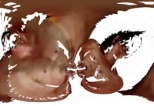The List Visual Arts Center's three current shows -- video installations, large-scale digitally manipulated chromogenic prints and an arcade video game -- all use scientific innovations for an artistic end.
"Technical innovations are of themselves just tools and resources. It is the challenge of the artist to realize their full potential," wrote art critic Charles Giuliano at boston.citysearch.com, calling the exhibitions "compelling and galvanic works."
STASI CITY AND CRAWL SPACE
British twins Jane and Louise Wilson transfer 16mm films to laser disc and project them onto walls, often with multiple projections per installation. Much of their work focuses on the abandoned interiors, resonating with the presence of those who once occupied the space or the activities that took place there.
Stasi City is a four-projection installation that explores the controversial history of the former headquarters of the East German secret police. The juxtaposition of lateral and vertical shifts through a labyrinth of corridors, interrogation rooms and doors reveals the subtle psychology of the space and indicates the power relations, surveillance and paranoia that characterized the Cold War.
Crawl Space is a short film with a suspense/horror motif. Projected on a single surface, it disjointedly follows the sisters through an abandoned house, replete with slamming doors, hints of telekinesis and amorphous shapes writhing beneath the wallpaper.
The Wilsons live and work in London, where they were recently nominated for the 1999 Turner Prize, an annual award sponsored by the Tate Gallery which is given to a promising new visual artist under age 40.
This exhibition, the Wilson sisters' first in the Boston area, is curated by Leila Amalfitano of the Rose Art Museum at Brandeis University.
BODY MAPPING
Selfportrait.map is composed of large-scale digitally manipulated chromogenic prints by the artist team of Lilla LoCurto and Bill Outcault. Working with a state-of-the-art full-body scanner that uses lasers to collect thousands of surface points of the body, the artists have processed this digital data through cartography software written specially for their project. The Boston Globe's Christine Temin described the resulting images of their own bodies mapped onto a two dimensional surface as "compelling and oddly poignant."
By using this type of imaging to map their own bodies instead of creating topographical maps, Ms. LoCurto and Mr. Outcault not only transform the concept of self-portraiture, but reference numerous art historical and scientific modes of representation, and address issues of veracity and societal changes incurred by technology.
Selfportrait.map was initiated in part by a 1996 grant from the MIT Council for the Arts to provide technological assistance to the artists. The exhibition includes 18 large-scale works, ranging from 2'x2' to 4'x8' as well as a computer station where gallery visitors may experiment with the mapping software. The exhibition was organized by Helaine Posner, an independent curator in New York and former curator at the List Center.
FUN WITH RUGS
KNOWMAD/MAP: Motion + Action = Place, an arcade video game that uses imagery from tribal rugs to ex-plore the end of the nomadic way of life, was created by the KNOWMAD Confederacy, which includes artists, computer game designers and one musician. KNOWMAD/MAP explores contemporary notions of national identity and sense of belonging in an era in which political boundaries are blurred by economic and cultural globalism as well as by technology which has created new virtual territories.
In a tented room replete with Middle Eastern rugs, visitors/players navigate through virtual tribal rug designs in a simulated 3-D world. These tribal rugs are repositories of cultural information, not only in terms of the symbolic significance of their designs, but through scholarly disputes regarding their origins.
"Unlike so many video games, it's not violence that's the point here, but a journey through a cushioned world of beauty, with gorgeous graphics and the fairy-tale possibility of saving the world," wrote Ms. Temin in the Boston Globe.
Mel Chin, creator and lead practitioner of the KNOWMAD Confederacy, has a long record of producing politically engaged and activist art through which he attempts to foster communication and understanding among disparate socioeconomic, ethnic and national groups. He will discuss his recent projects on March 9 at 6:30pm in Rm 10-250 in a talk co-hosted by MIT's Visual Art Program and the List Center.
A version of this article appeared in MIT Tech Talk on March 8, 2000.






